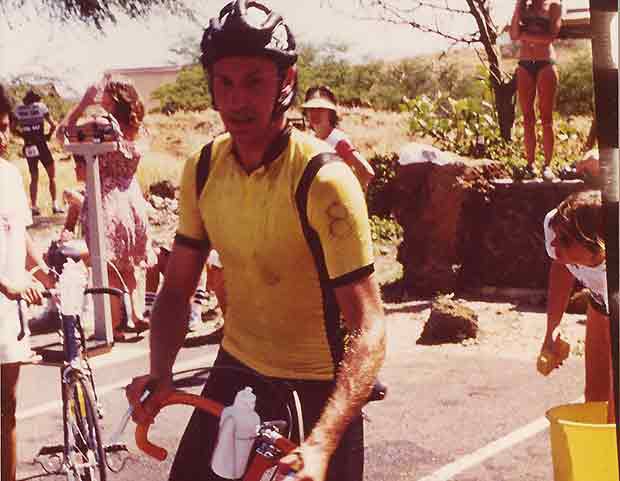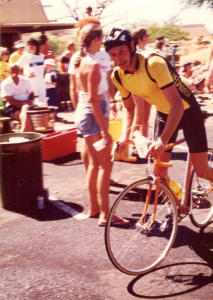
I’m not an original IRONMAN but I do go pretty far back, probably enough to share some pictures memorializing things I’ll bet you didn’t know. I’ll embed them here and most pics have never been shown outside of my scrapbook. I’ll use this opportunity to tell how you I feel about the move from historic IRONMAN to the new and improved (or not) IRONMAN World Championships.
Let’s talk about history and legacy and how that has been honored throughout the IRONMAN as I have known it. Much of that history was abandoned the year I first traveled to race the IRONMAN. I would be racing on a new course in a new place as the IRONMAN World Triathlon – one of the race’s various names (as we shall see) – was moved off the Hawaiian island where it was born. The race that Barry McDermott made famous in his Sports Illustrated article, and where the ABC Wide World of Sports presented the race to the world, was gone, replaced by something new.
I raced the IRONMAN World Championship in 1981, its first year in Kona. I believe somewhere between 380 and 400 registered for the race, 326 started, 300 finished. There were no cut-off times. We started at 7:15am and I remember eating breakfast at Uncle Billy’s Kona Bay Resort on Alii Drive the following day and the last two finishers came by. The final finisher, in 27 hours, was 74 year-old Walt Stack.

About that name. On the island it was known as the Nautilus International Triathlon. You can see this in the image above if you squint. It’s on a banner that designates the run finish. Yes, that finish line had about as much glamor as a prominent regional 5k. But I promise you the race was as big a deal for we 326 who started as it is for you all today. Whether it was or wasn’t called or recognized as a world championship, we all knew exactly what this race meant. No governing body could bestow or withhold that we were at the premier test of all-around ultradistance breadth, skill and fitness. That is the legacy and the history and that has not changed.
It never crossed my mind that the race organizers dishonored the 3-year history of the race by decamping for a different Hawaiian Island. What drew us there was not the name; or the location; or even the precise distance (and as you’ll see the distance was kind of fungible even back then). What drew me to that island for that race were the other 300-odd competitors. Most of us did not know each other; had never met one another; and had never even met anyone else who’d done this event. Most us were the only triathletes in our towns and if we told anyone that we competed in triathlons we were surely made to explain what that was.

About that course. What you see here is me riding into the weigh station. You might know this, or not, but in 1981 the race was still a medical unknown. Nobody had ever heard of hyponatremia or SIPE and they didn’t know what constituted medical “trouble.” When was the athlete at his or her limit? They decided the metric was weight. If any competitor lost 10 percent of his or her weight at any time during the race, that would result in a medical DNF. We were weighed pre-race, Thursday I think, and they weighed us 5 times during the race (according to memory). Somebody with a clipboard was at each weigh station with the pre-race weights of 326 athletes. We were weighed at the bike turnaround at Hawi, and here in these images at Hapuna Beach, 70 miles into the ride. Then at the bike finish and at 18 miles into the run. That leaves one more weigh station and I don’t remember where that was. I believe this was the only year, before or since, of the weigh stations.
I bring this up for novelty reasons but also because the course was planned out before the weigh station idea was hatched. Then the organizers had to decide where to safely put the weigh stations and that required us to ride to each of them. We rode all the way into Hawi and up a side street, and on the way back we rode from the Queen K Highway to Hapuna Beach and back. We finished at the Kona Surf Hotel (which I believe is now the Keauhou Kona Surf and Racquet Club Resort). This is where the bike leg finished until at least well into the 1990s if not later. What I have heard is that the bike course that year as ridden measured 115 miles.

Not only were they scales, they were the doctor’s office scales. We had to wait our turns, step on, stand there while the volunteer slid the weights along the balance bars. Note in the image above the t-shirts that said Nautilus. The charming and gracious Valerie Silk, who owned and ran this race with skill and love until it sold in 1989 was also by marriage (if I remember right) involved with Nautilus Fitness centers on Oahu. Apocryphally, I believe through a separation of assets the husband got the Nautilus centers and Valerie got the race. (If I misremember I’ll post a correction at the bottom.)
You might find laughable my helmet and my front hydration. I was also riding clip & strap pedals with cleats that attached to the leather sole of the shoe by nails. One did literally – like a cobbler - nail the cleats into the shoes. This wasn’t retro. This – and all the rest on my 10-speed (2 chain rings, 5 cogs) Colnago – was state of the art. If you went to any bike race this is pretty much what was getting ridden. My first bike was a used Raleigh International and I upgraded by buying that Colnago frame, also used. I swapped the parts over, sold my frame, and 2 owners later at this very 1981 IRONMAN I saw Ken Shirk, aka Cowman, roll up to bike check-in on my old Raleigh frame.

The run course came up out of the Kona Surf Hotel and turned left toward Kailua-Kona. Not right, to descend into The Pit, as went the run course starting in the mid 90s. In fact, I can’t count how many times this course has changed. Note in the images higher up the flag line denoting the swim start. That double-masted turnaround boat didn’t change its location when the swim start was pushed to the end of the pier. Yes, the swim was longer back then. As for the run course, I don’t remember us going down into the Natural Energy Lab. We might’ve. But I think we might’ve run all the way to the airport.
Both transition areas have changed quite a bit. T1 started on the pier and for quite a few years moved to the parking lot in back of the King Kam, the historic place for the carbo load and the awards. Then moved back to the pier. The swim has finished on both sides of the pier. T2 and T1 were 6 miles apart from each other for the first 15 or 20 years.
At this race I met some of those who would be my dearest friends throughout my life. My first year was also the debut IRONMAN races for Mark Montgomery, Monty on our Reader Forum, who is today my next door neighbor. It was also the debut year for Scott Tinley and Scott Molina. Mark Allen would follow a year later. I’d be interested in knowing what these fellows think of the recent decision by IRONMAN to alternate men’s and women’s race days in Kona, alternating with another location (rumored to be Nice, France, at least in the beginning). The point I’m trying to make – well or poorly – is that I doubt many or any of us from that generation object to the changes the IRONMAN has just made because the legacy isn’t the course or the location. It’s the people who raced then and who race now. In the beginning this race was not about the location, but the people. I don’t remember one person ever complaining that they’d moved the location off the “historic” Oahu course.

About two in every three reading this don’t agree with me. I respect your opinion. What has always concerned me is that something would happen on that island that would foreclose on the IRONMAN World Championship being held there. I just never knew whether it would be local sentiment or Madame Pele (have you been watching the news about Mauna Loa’s eruption?). I’m quite happy with the decision IRONMAN has made because it keeps the race on the island while simultaneously preparing us in mind and body should we ever have to move. As for the other elements of this decision for which IRONMAN is criticized we’ll enter the lightning round where I'll need to be quick.
Roughly doubling the field size by producing two races per year: Above is my invitation to participate in the 1982 IRONMAN. No qualification necessary. No validating race. Just pay the entry fee. What I wish for everyone is the chance to race this race, and it would be nice if it was as easy for you as it was for me. As long as my major competitors toe the line with me it doesn’t bother me whether there are 1,400 or 2,800 other men racing.

About a new location: If it’s Nice, let me just say: I attended the Nice race 4 times and raced it twice back in the 80s and early 90s. This is back before IRONMAN took over the race, and back then it was a 4k swim, 120k bike, 30k run. This was always my favorite trip of the year. If you get a chance to race this world class course, I suspect you'll have the time of your life. I envy those men who'll race Nice this year (if indeed the Nice rumors are true) because you’re reprising what we did back in 1981, when we cut the ribbon on an entirely new course and were part of a historic debut. I’m happy for those who live in Europe, who’ve been solid fans of IRONMAN all these years, and who now have the chance to own a part of our sport’s world championship and who'll presumably be able to travel to and race it without spending a fortune. For those in Europe who do want to race in Kona, I’m glad if they get to race on their home continent. In fact, just about anyplace in western Europe is about a third shorter fly time from the U.S. East Coast than is Kona.
About women getting their own day: About damned time. Here is my prediction: The race in 2024 will be historic and will alter the trajectory of women’s mass endurance sport participation in southern Europe. Women’s IRONMAN and marathon participation rates are quite low in countries with a border on the Mediterranean. The optics of a world championship, with thousands of women both age group and pro swarming any Mediterranean location for this race could be a Title IX moment for that region. I will certainly want to be there to spectate that. When I raced IRONMAN in 1981 fewer than 20 women participated. Today in many countries at least 1-in-3 who participate in an IRONMAN are women. And as you’ll see, from that invitation letter, in 1981 you were referred to as IRONWOMEN. So much for tradition!



